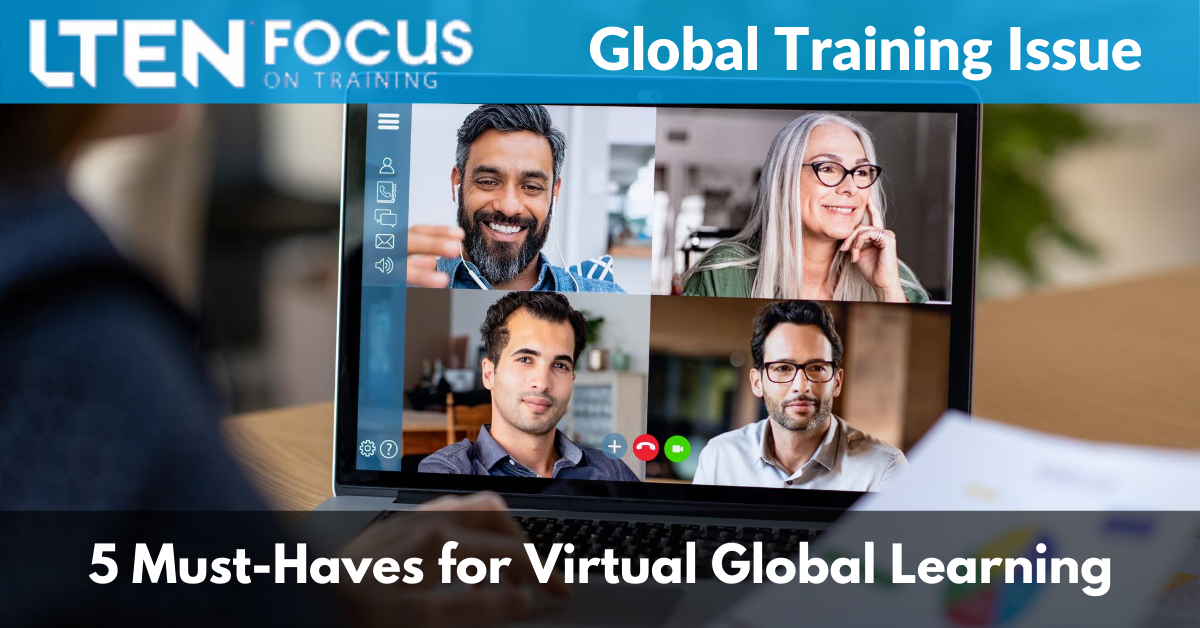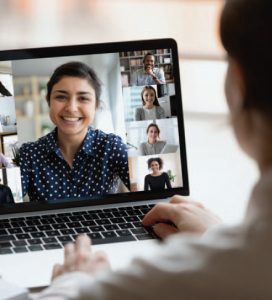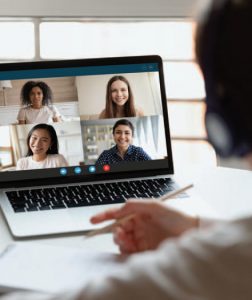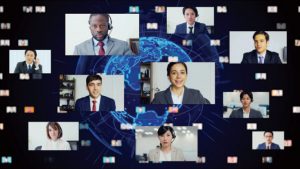
5 Must-Haves for Virtual Global Learning
FEATURE STORY – By Andria Cox
Many things contribute to success, but five key areas stand out as must-haves.
The world went remote overnight, and that created a new environment for virtual synchronous learning development and anxiety over how to bring global teams together.
Sanofi Genzyme recently developed a large-scale learning program creation for the rare diseases franchise. The project includes 62 e-learnings across the scope of rare diseases. At the time of creation, we had the ability to have some people in-person in the office with others on Zoom. However, the proportion of live attendees to virtual attendees was small, and the entire project could run again successfully in our current remote environment.
To that end, we learned a lot about how to bring together more than 90 cross-functional internal team members from 13 different teams, with global and regional representation, in a predominantly virtual environment to create a comprehensive learning program for each therapeutic area (TA) and have some insights to share on what contributed to the program’s success. Companies denote TAs differently.
An example of a TA in rare diseases is Pompe disease. Under the Pompe disease TA, learning needs address TA components such as disease state, anatomy and physiology, pathology, diagnosis, differential diagnoses, treatment and management, product information, clinical publications and the therapeutic area landscape.
Though many small factors along the way contributed to the successful development of this program, five key areas stand out as musthaves: executive sponsorship, a core team, an extended team of subject matter experts (SMEs), a defined contribution process and a strategic supplier partner.
Executive Sponsorship
Executive sponsorship leads to increased involvement and timely contribution. Executive sponsors who believe in quality learning to upskill their teams provide high-level accountability for all members to contribute meaningfully and prioritize the program development.
We work in teams where everyone is busy and has different and sometimes conflicting priority deliverables, and this may increase difficulty for SMEs to find the time for multiple rounds of content development and reviews, especially on the tight timelines required to meet deadlines and deliver the learning. Amidst busy schedules and difficult decisions, you cannot underestimate the importance of an executive sponsor who supports learning and development and serves as a champion and advocate with the charge for team members to prioritize the learning program development and to be the voice of the business case for budget allocation.
 Fortunately, at the time of program development, we did not have to actively seek out an executive sponsor, as we had proactive sponsorship from Sébastien Martel, global head of the rare diseases franchise, Sanofi Genzyme. Ideally, executive leaders commit to quality deliverables to increase competencies. If you do not have this level of sponsorship, start building sponsors now with the strong business case for learning to drive organizational objectives and up-skill your internal talent.
Fortunately, at the time of program development, we did not have to actively seek out an executive sponsor, as we had proactive sponsorship from Sébastien Martel, global head of the rare diseases franchise, Sanofi Genzyme. Ideally, executive leaders commit to quality deliverables to increase competencies. If you do not have this level of sponsorship, start building sponsors now with the strong business case for learning to drive organizational objectives and up-skill your internal talent.
Perhaps counterintuitively, when developing a global learning program, you must slow down to speed up.
Core Team
The many viewpoints contribute to a globally driven learning initiative; therefore, it is indispensable to have an appointed core team to streamline key decision-making
and serve as a liaison between the company and the supplier partner. This team develops the process flow, manages the internal stakeholders’ participation and partners with the supplier to ensure a seamless flow of communication and deliverables.
Ideally, the core team has diverse representation to reflect the SME population. If the learning aims to serve commercial and medical, through customization for each role and the corresponding review processes, then the core team needs representation from the key contributors of both areas. The ideal size of a core team is around six to eight team members. Any more than this dilutes effectiveness and efficiency.
In ideal situations, the core team will have a charter that outlines roles, responsibilities, frequency of meetings and primary means of communication and will form an escalation clause for instances when signs emerge that the project starts to go off the rails without response to the core team’s guidance. In a project of any size, especially larger projects with more deliverables, SMEs and opinions, it is best to anticipate that you will need to have a plan for when things start to deviate — it is only natural.
Extended Team — SMEs
Perhaps counterintuitively, when developing a global learning program, you must slow down to speed up. This means that the core team needs to do a thorough analysis of key global and regional contributors.
It is important to know, or get to know, your global and regional medical and commercial team members. If you are not sure where to start, ask the heads of each global and regional function who they identify as the key SMEs. Once you engage in conversation with these SMEs, you can identify key leads per TA and, even further, per product within each TA. It is best to find a balance where each voice has a seat at the table for content creation and review, along with not having so many SMEs that it prohibits consensus and forward progress.
The significance of inviting global and regional medical and commercial SMEs to the development process is that it ensures a global mindset to account for nuances, to create a consistency of voice to refine a lexicon and to provide the content and context in the end-product. Contributing SMEs will have the opportunity to keep track of local and role customizations needed throughout program development and the knowledge to communicate the “why” and “what” amongst their local teams.
This level of involvement incorporated in our large-scale program development generated a strong sense of being one global team and collective pride in the jointly created learning program. We found that keeping the SMEs to 15 or fewer per TA provided the best balance. This may sound like a lot of SMEs, particularly when we often work with fewer SMEs on smaller-scale projects. The key to inclusion of multiple SMEs through a meaningful experience to generate quality learning is to have a clearly defined contribution process that allows flexibility in the ways and times that SMEs contribute.
Contribution Process
Define your process early, try it out, iterate from what clearly does not work as planned and then stick to it. With 90-plus SMEs across the globe, it was critical to have a defined process for contribution, participation and approval pathways. When the process is in place, team members may propose alterations intended to improve efficiency or to decrease review times. It is important to have an open mind to consider and test these tweaks in some cases, if they do not remove critical SMEs from the conversation. If you want to have a program that receives global embrace and adoption, the right people must be at the table to hear and consider ideas and different approaches to implement where appropriate; this builds a cohesive voice for the overall team and creates buy-in across the organization.
 An effective and efficient process necessitates strong project management from the core team.
An effective and efficient process necessitates strong project management from the core team.
An effective and efficient process necessitates strong project management from the core team to ensure the right people are invited to the right meetings, receive the right source files for review and commentary, and to schedule all the meetings and calendar reminders.
When you create a global program, you basically throw in the “kitchen sink” to meet as many needs of as many people as possible. Having a cross-functional SME team ensures that each region and function stays current on the storyboard and can localize or customize early upon final storyboard approval instead of having to wait for the functional build completion of each module. This allows roles and regions to redact and submit through local approval pathways pertinent to the scope of each role and for geographical considerations.
Here is a high-level overview of the most efficient process on which we landed:
- Global and regional teams provide all assets in use across the globe.
- Analyze for gaps, accuracy and currency.
- Cross-functional teams contribute to create a high-level topic content outline.
- Content outline gets fleshed out into a comprehensive storyboard.
- All Extended Team contributors provide feedback in track changes mode
before the live call. - Initial feedback from everyone is due two business days before the live call.
- Set a calendar reminder that shows as “free” to remind SMEs that feedback is due by EOB the next day.
- If an SME cannot attend the call or provide feedback in the document, they can select a stand-in from their team for that portion.
- All Extended Team contributors provide feedback in track changes mode
- The supplier partner receives all feedback to assimilate, incorporate and add questions or comments in the two business days before the live call.
- The following live call with the supplier partner only covers the areas of edits, comments and questions submitted from the SMEs. Live discussion, via videochat or in-person, allows the team the opportunity to talk through differences in content, context and approaches to make an aligned decision for global direction.
- If the entire SME team does not find concern with content accuracy and context in the content outline or storyboard document, these portions do not get covered in the live call.
- The live call should not be the first time a SME sees the document.
- If they forgo their ability to contribute via commentary in the shared document or provide a stand-in contributor, they forgo contribution in that review phase and may provide feedback in a later review phase.
- The global medical director and global brand lead must stay consistent for the entire review process per e-learning module.
- The learning team reviews the content from the learner’s perspective and evaluates the user experience (UX) to ensure alignment of interaction with learning objectives and the learner’s experience in each component.
- Medical director and global brand lead sign-off on final storyboard and custom graphics.
- Learning team tests functional build-in learning management system pilot environment.
- Modules move to live site as individual objects or curricula, depending on your program design.
- Localization and customization per role and geography are the responsibility of the regions and functions – from a global level, there is not a singular review that addresses every need of every role and location. Another reason why cross-functional SMEs are important along the way is their ability to note changes needed for local and role versioning.
Strategic Supplier Partner
 When selecting a supplier partner for global learning development, it is important to ensure that they have the right team members to meet the project’s needs. For example, when creating a global medical learning program, it is not advised to select a partner that does not have medical writers on staff. The difference between a supplier partner and a strategic vendor partner rests in the strategic vendor partner’s ability and willingness to understand the business needs and the patient populations served and to challenge you to think of new and innovative ways to present the information to your global SMEs for enhanced participation and contribution.
When selecting a supplier partner for global learning development, it is important to ensure that they have the right team members to meet the project’s needs. For example, when creating a global medical learning program, it is not advised to select a partner that does not have medical writers on staff. The difference between a supplier partner and a strategic vendor partner rests in the strategic vendor partner’s ability and willingness to understand the business needs and the patient populations served and to challenge you to think of new and innovative ways to present the information to your global SMEs for enhanced participation and contribution.
We partnered with a boutique digital science and medical communications firm out of Toronto, Canada. It may seem counterintuitive to select a boutique firm for such a large-scale learning initiative. However, our supplier scaled up their organization specific to the needs of the project. They also codified the content outline and storyboard process to indicate which content came directly from labeling, clinical reprints, core internal source documents, was directly submitted by SMEs or content that they wrote to construct the narrative. This significantly streamlined the review process.
We also worked with our supplier to create a UX legend so that the learning team could evaluate the proposed UX per screen against the content to check for delivery alignment against learning objectives. Having a numbered UX system allowed for the SMEs to focus on ensuring the accuracy and integrity of the content and context and for the learning team to evaluate this against the design. While we had dedicated teams from the supplier for each TA, we also had a universal reviewer to ensure consistency of voice and feel across all modules.
The supplier led the live SME calls, which allowed for active participation from the learning SMEs and TA SMEs. By the end of the program development, we had globally agreed upon frameworks for each module’s approach and a 33-page document of custom iconography that also provided consistency for learner recall.
For this large and specialized program development, we needed a supplier dedicated to the project as if it were their own business program for learning development. We wanted something custom, fresh and daring enough to try new and innovative ways to transform content with a tailored approach. Therefore, consider the needs of your project and team. What do you need from a supplier? From the experience with this large program, it became clear that we needed someone who saw this as more than just mass-production of elearnings.
Bringing It All (Work From) Home
Successful global learning development requires a team with a global mindset and global representation of the learning population. Content is not king. In fact, content without context is lackluster and does not deliver the meaningful, relevant learning transformation needed to pull through desired behavior changes and create the optimal experience for learner interaction with the information.
Recognize that the language of learning is a foreign language to many content experts and be patient with yourselves and your teams as you embark on new endeavors. The learning creation is, itself, a learning process.
The better we facilitate the process for our teams, the better champions they become and the more they look forward to pulling through sound learning design in other areas of the business. With a rapid conversion to remote work, learning stands to provide meaningful and immersive experiences that can lift our teams’ spirits and allow for openness to explore what the new normal might be beyond the pandemic.
In a time and place where many previously reported not having time to learn during the week, now more than ever, we have a real opportunity to demonstrate the difference sound learning design can make and how the development process can bring our teams even closer together. Whether working from home or home office, these five must-haves can really make the difference in your next global learning development initiative.
Andria Cox is global digital and learning design director, Sanofi. Email her at
andria.cox@sanofi.com. The views and opinions expressed in this article are those of
the author and should not be attributed to the author’s employer.
Summer 2020









